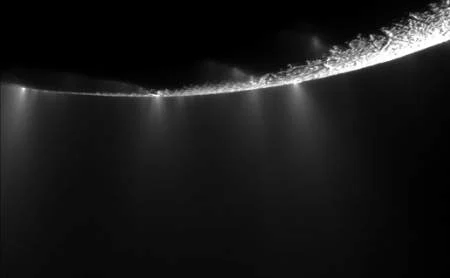NASA has released a series of images that reveal a “forest” of geysers spraying ice from prominent fissures along the south polar region of Enceladus.
The pictures – snapped by the Cassini spacecraft during a recent flyby over one of Saturn’s 61 moons – also include “the best” 3D scans ever obtained of a “tiger stripe,” or a fissure that sprays icy particles, water vapor and organic compounds.

“Enceladus continues to astound,” said Bob Pappalardo, Cassini project scientist at NASA’s Jet Propulsion Laboratory in Pasadena, Calif.
“With each Cassini flyby, we learn more about its extreme activity and what makes this strange moon tick.”
Carolyn Porco, imaging team lead based at the Space Science Institute in Boulder, Colo, explained that the latest flyby allowed scientists to search for new or smaller jets which weren’t visible in previous images.
For example, researchers counted more than 30 individual geysers in one mosaic, including more than 20 that had not been seen before.
“This last flyby confirms what we suspected,” said Porco. “The vigor of individual jets can vary with time and many jets, large and small, erupt all along the tiger stripes.”
According to Porco, one new new map which combines heat data with visible-light images shows a 40-kilometer (25-mile) segment of the longest tiger stripe, known as Baghdad Sulcus.

The high-resolution map illustrates the correlation between the geologically youthful surface fractures and the anomalously warm temperatures that have been recorded in the south polar region.
In addition, the broad swaths of heat previously detected by the infrared spectrometer appear to be confined to a narrow, intense region no more than a kilometer (half a mile) wide along the fracture.
Indeed, peak temperatures along Baghdad Sulcus exceed 180 Kelvin (minus 135 degrees Fahrenheit) and may be higher than 200 Kelvin (minus 100 degrees Fahrenheit).
The relatively warm temperatures likely result from heating of the fracture flanks by warm, upwelling water vapor that propels the ice-particle jets observed by Cassini’s cameras.
“The fractures are chilly by Earth standards, but they’re a cozy oasis compared to the numbing 50 Kelvin (-370 Fahrenheit) of their surroundings,” said John Spencer, a composite infrared spectrometer team member based at Southwest Research Institute in Boulder, Colo.
“The huge amount of heat pouring out of the tiger stripe fractures may be enough to melt the ice underground. Results like this make Enceladus one of the most exciting places we’ve found in the solar system.”






